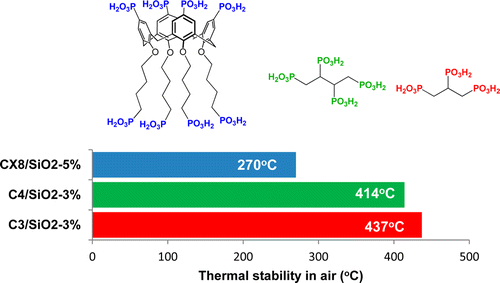当前位置:
X-MOL 学术
›
Chem. Mater.
›
论文详情
Our official English website, www.x-mol.net, welcomes your
feedback! (Note: you will need to create a separate account there.)
Silica-Supported Phosphonic Acids as Thermally and Oxidatively Stable Organic Acid Sites
Chemistry of Materials ( IF 7.2 ) Pub Date : 2016-08-18 00:00:00 , DOI: 10.1021/acs.chemmater.6b02027 Alexandre Charmot 1 , Andrew Solovyov 1 , Antonio G. DiPasquale 2 , Alexander Katz 1
Chemistry of Materials ( IF 7.2 ) Pub Date : 2016-08-18 00:00:00 , DOI: 10.1021/acs.chemmater.6b02027 Alexandre Charmot 1 , Andrew Solovyov 1 , Antonio G. DiPasquale 2 , Alexander Katz 1
Affiliation

|
Organic–inorganic materials consisting of organophosphonic-acid-supported-on-silica materials C3/SiO2 and C4/SiO2 are described, where C3 is propane-1,2,3-triphosphonic acid and C4 is butane-1,2,3,4-tetraphosphonic acid. Solid-state structures of both of these phosphonic acids are analyzed using single-crystal X-ray diffraction, and these data reveal extensive intermolecular hydrogen bonding and no intramolecular hydrogen bonds. Thermogravimetric analysis/mass spectroscopy (TGA/MS) data show a lack of combustion for these materials in air at temperatures below 400 °C, and only release of water corresponding to reversible organophosphonic acid condensation below 150 °C. A comparative series of silica-supported materials were synthesized, consisting of organophosphonic acid CX8, which represents a calixarene macrocycle that is decorated with a high density of organophosphonic-acid substituents on both the lower and upper rim, as well as polyvinylphosphoric acid (PVPA). Material CX8/SiO2 possesses a significantly lower thermal stability and lower combustion temperature of 300 °C in air, whereas PVPA demonstrates comparable thermal stability as observed with C3 and C4. TGA coupled with base-probe titration was used to determine the Brønsted acid site density of all silica-supported phosphonic acids at various coverages and temperatures. Material C4/SiO2-37% (corresponding to 37% (by mass) loading and half-monolayer coverage on silica) exhibited the highest Brønsted acid-site density of all materials, corresponding to 0.84 mmol/g at 150 °C, and 0.62 mmol/g at 300 °C. All supported phosphonic acids treated with pyridine at room temperature were strong enough acids to protonate pyridine at room temperature as exhibited by a distinct pyridinium cation band in the infrared spectrum; however, in contrast to much stronger acid sites in silica-supported phosphoric acid materials, almost all adsorbed pyridine was lost by 150 °C. Use of a stronger base for acid-site titration consisting of diisopropylamine (DIPA) demonstrates acid sites in all materials up to 300 °C, at which temperature the acid site was too weak to adsorb DIPA. Thus, these oxidatively stable materials are deemed to be useful in applications requiring weak Brønsted acid sites, while exhibiting high-temperature oxidative stability up to 400 °C.
中文翻译:

二氧化硅支持的膦酸作为热和氧化稳定的有机酸位点
描述了由有机膦酸负载的二氧化硅材料C3 / SiO 2和C4 / SiO 2组成的有机无机材料,其中C3为丙烷1,2,3-三膦酸和C4是丁烷-1,2,3,4-四膦酸。使用单晶X射线衍射分析了这两种膦酸的固态结构,这些数据显示出广泛的分子间氢键且没有分子内氢键。热重分析/质谱(TGA / MS)数据表明,这些材料在低于400°C的空气中缺乏燃烧,仅释放出低于150°C的可逆有机膦酸缩合的水。合成了一系列由二氧化硅支撑的比较材料,其中包括有机膦酸CX8(代表杯芳烃大环,在上下边缘均装饰有高密度的有机膦酸取代基)和聚乙烯基磷酸(PVPA))。CX8 / SiO 2材料在空气中的热稳定性和燃烧温度均低得多,在空气中为300°C,而PVPA具有与C3和C4相当的热稳定性。TGA结合碱探针滴定法用于确定在各种覆盖率和温度下所有二氧化硅负载的膦酸的布朗斯台德酸位点密度。材料C4 / SiO 2 -37%(对应于37%(质量)的负载量和在二氧化硅上的半单层覆盖)显示出所有材料中最高的布朗斯台德酸中心密度,分别对应于150°C下的0.84 mmol / g和300°C下的0.62 mmol / g 。如在红外光谱中独特的吡啶鎓阳离子带所显示的,在室温下用吡啶处理的所有负载的膦酸都是足以在室温下使吡啶质子化的强酸。然而,与二氧化硅负载的磷酸材料中强得多的酸位相反,到150°C,几乎所有吸附的吡啶都消失了。使用由二异丙基胺(DIPA)组成的更强的碱进行酸位滴定表明,所有材料中的酸位均高达300°C,在此温度下,酸位太弱而无法吸附DIPA。因此,
更新日期:2016-08-18
中文翻译:

二氧化硅支持的膦酸作为热和氧化稳定的有机酸位点
描述了由有机膦酸负载的二氧化硅材料C3 / SiO 2和C4 / SiO 2组成的有机无机材料,其中C3为丙烷1,2,3-三膦酸和C4是丁烷-1,2,3,4-四膦酸。使用单晶X射线衍射分析了这两种膦酸的固态结构,这些数据显示出广泛的分子间氢键且没有分子内氢键。热重分析/质谱(TGA / MS)数据表明,这些材料在低于400°C的空气中缺乏燃烧,仅释放出低于150°C的可逆有机膦酸缩合的水。合成了一系列由二氧化硅支撑的比较材料,其中包括有机膦酸CX8(代表杯芳烃大环,在上下边缘均装饰有高密度的有机膦酸取代基)和聚乙烯基磷酸(PVPA))。CX8 / SiO 2材料在空气中的热稳定性和燃烧温度均低得多,在空气中为300°C,而PVPA具有与C3和C4相当的热稳定性。TGA结合碱探针滴定法用于确定在各种覆盖率和温度下所有二氧化硅负载的膦酸的布朗斯台德酸位点密度。材料C4 / SiO 2 -37%(对应于37%(质量)的负载量和在二氧化硅上的半单层覆盖)显示出所有材料中最高的布朗斯台德酸中心密度,分别对应于150°C下的0.84 mmol / g和300°C下的0.62 mmol / g 。如在红外光谱中独特的吡啶鎓阳离子带所显示的,在室温下用吡啶处理的所有负载的膦酸都是足以在室温下使吡啶质子化的强酸。然而,与二氧化硅负载的磷酸材料中强得多的酸位相反,到150°C,几乎所有吸附的吡啶都消失了。使用由二异丙基胺(DIPA)组成的更强的碱进行酸位滴定表明,所有材料中的酸位均高达300°C,在此温度下,酸位太弱而无法吸附DIPA。因此,


















































 京公网安备 11010802027423号
京公网安备 11010802027423号